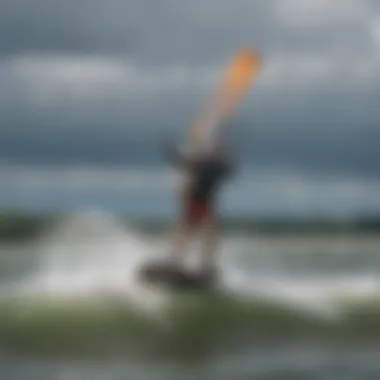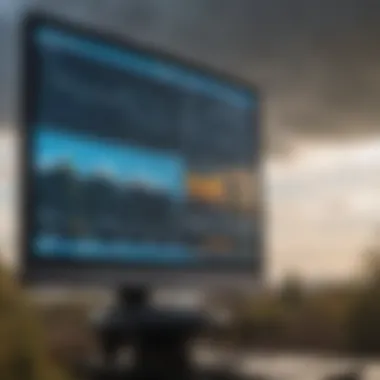Weather Radar Insights for Kingston, NY Residents


Intro
Understanding the intricacies of local meteorology is critical for outdoor enthusiasts, especially for those kiteboarding in Kingston, NY. With the Hudson River acting as a playground for adventure sports, weather conditions can rapidly change, making it essential to stay updated with the latest developments. This article dives into the workings of weather radar and its pivotal role in managing kiteboarding adventures and ensuring safety in the local community. As we unravel this complex yet vital subject, we’ll discuss the technology behind weather radar systems and how they can directly impact the decisions made by kiteboarders and other outdoor adventurers.
Gear Insights
Before hitting the water, having the right gear is crucial. Whether you're a novice or an experienced kiteboarder, understanding what works best for local conditions will give you an edge.
Latest Gear Reviews
In Kingston, the choices for kiteboarding gear aren’t just overwhelming; they’re ever-evolving. Brands like Naish and Slingshot constantly innovate, introducing new kites and boards tailored for various skill levels and weather conditions. For instance, the Naish Pivot has been praised for its versatility, making it suitable for both beginners and experts alike. It performs well in gusty winds, which is common around the river.
Another noteworthy mention is the Slingshot Freestyle, particularly praised for its stability in choppy waters. This model has received positive feedback from local riders. But as always, personal fit is key; what works for others may not be your perfect match.
Essential Gear for Beginners
Starting out in kiteboarding? You’ll want to make sure you have a few essentials:
- Kite: Start with a smaller size kite which is easier to handle.
- Board: A beginner board should have a larger surface area for stability.
- Harness: A comfortable harness to support your weight when flying the kite.
- Safety Equipment: Always carry a helmet and impact vest to protect yourself.
Having the right gear not only enhances your experience but significantly contributes to your safety on the water.
Techniques and Tips
Once you’ve got the gear sorted, it’s time to brush up on techniques and safety practices.
Advanced Tricks and Techniques
For seasoned kiteboarders in Kingston looking to up their game, mastering advanced maneuvering can be thrilling. Learning to jump, spin, and perform tricks like the handle pass requires patience and practice.
Additionally, understanding wind patterns and how to navigate them is vital. Many kiteboarders prefer to ride during the late afternoon when thermal winds are more predictable. Checking local weather radar helps determine wind shifts that can make or break a session.
Safety Practices for Kiteboarders
Safety should never take a back seat, especially in unpredictable waters. Here are some practices every kiteboarder should keep in mind:
- Pre-Check Conditions: Use weather radar to verify wind speeds, precipitation, and storm activity.
- Buddy System: Always kite with a friend; it’s safer and much more fun.
- Escape Plan: Know your exit points. The Hudson can be tricky, so have a plan to safely get back to shore.
Always stay informed about sudden weather changes. A good radar will save you from being caught off-guard.
By understanding weather radar and using it effectively, kiteboarders in Kingston can enjoy their time on the river while minimizing risks. The marriage of technology and outdoor sport not only enhances personal experience but also fosters safety within the community.
Intro to Weather Radar
Understanding the intricacies of weather radar is more than merely grasping a scientific tool; it's about appreciating how such technology transforms the way we interact with the environment, especially in Kingston, NY. In this region, where diverse climatic conditions frequently converge, weather radar plays a vital role. For kiteboarders and outdoor enthusiasts alike, this technology is as essential as a trusty compass on a sailing adventure. The more one understands about how weather radar operates and its significance, the better prepared they become to tackle unpredictable weather and optimize their experiences.
Defining Weather Radar Technology
At its core, weather radar technology involves the transmission and reception of radio waves. When these waves hit precipitation particles—be it rain, snow, or hail—they are scattered back to the radar antenna. This technique allows meteorologists to discern not just the location of precipitation but also its intensity and movement.


In Kingston, this means localized weather phenomena can be observed with precision, allowing for timely alerts and forecasts that can be crucial for planning outdoor activities. Moreover, as society becomes increasingly reliant on real-time data, the importance of such technology cannot be overstated. Weather radar isn't just a tool that delivers numbers; it creates a vivid picture of ongoing weather patterns.
Historical Development of Weather Radar
The journey of weather radar technology spans several decades, evolving from simple devices into sophisticated systems that can provide complex data in real-time. The origins trace back to World War II when radar was primarily used for military purposes. As the war ended, scientists recognized its potential for meteorological applications.
In the late 1940s and early 1950s, the first weather radar systems were constructed, marking a significant milestone in meteorology. Kingston, like many other areas, gradually saw the implementation of these systems, which allowed for better storm tracking and warning capabilities. Fast forward to today, and we see dual-polarization radar systems that can differentiate between types of precipitation. This development has drastically improved forecasting accuracy and has become a game-changer for local meteorologists.
Together, these aspects of weather radar not only illustrate its technical evolution but also underscore its significance in enhancing safety measures and aiding in the management of outdoor activities. As we delve deeper into the workings and implications of weather radar, one begins to see just how interwoven this technology is with our day-to-day lives in Kingston.
How Weather Radar Works
Understanding how weather radar operates is crucial for grasping its significance in analyzing and forecasting weather patterns, especially in Kingston, NY. Weather radars play an integral role in not just predicting local meteorological phenomena but also in making informed decisions, particularly for kiteboarders and outdoor enthusiasts. This segment will break down the key principles of radar operation, delve into the various types of radars used, and discuss how data collected is interpreted.
Basic Principles of Radar Operation
At its core, the basic principle behind radar involves sending out radio waves and analyzing their reflections. When these waves strike objects, like raindrops or snowflakes, they bounce back to the radar system. The time taken for the signal to return helps determine the distance of the object. Furthermore, the strength and frequency of the reflected waves also allow meteorologists to gauge the size and intensity of precipitation.
A critical aspect of radar operation is that it not only captures the presence of precipitation but also assists in identifying storm structures. For instance, the Doppler effect, which measures the change in frequency of waves due to movement, is essential in tracking wind speed and direction. This can be particularly handy in Kingston, where sudden storms can arise, impacting local kiteboarding conditions.
Types of Weather Radars
Weather radar technology is not monolithic. There are varied systems designed to cater to different meteorological needs. Here, we'll take a closer look at two primary radar types: Single-Polarization Radar and Dual-Polarization Radar.
Single-Polarization Radar
Single-Polarization Radar sends out a single beam of radio waves, effectively providing a basic overview of precipitation. The main contribution of this technology lies in its ability to measure the reflectivity of precipitation, which is useful for determining rainfall rates. It is often deemed a
common choice in many regions because it’s simpler and less expensive to deploy compared to more advanced systems.
However, it has limitations. Its inability to differentiate between various types of precipitation means that it can misinterpret rain and snow conditions. For kiteboarders who rely on precise conditions, knowing the difference between a light drizzle and a significant snow could be significant.
Dual-Polarization Radar
On the flip side, Dual-Polarization Radar sends out two different beams of radio waves, offering an enriched perspective by measuring both horizontal and vertical properties of precipitation. This capability allows for a more detailed analysis of what’s falling from the sky.
The key characteristic here is its heightened ability to distinguish between types of precipitation—such as rain, snow, or hail—enhancing accuracy in weather forecasting. For our adventurous kiteboarders, this extra detail can make a huge difference in preparation.
Yet, this advanced radar is more complex and expensive to operate, which might limit its availability in some areas. Still, towns like Kingston benefit immensely from this technology, as it leads to safer outdoor activities.
Data Collection and Interpretation
Once the radar systems collect data, the interpretation becomes a crucial step. Weather data must be analyzed correctly to ensure that actionable insights can be provided to the community. Professionals interpret the signals that the radar sends back, converting raw reflections into readable information about weather patterns.
Often, this involves looking at graphical displays and numerical data points to predict conditions over specific periods. For kiteboarders, such precise data interpretation informs decisions about when to hit the water and when to stay ashore. Thus, the synergy between collected data and localized understanding significantly elevates safety and enjoyment during outings.
In summary, comprehending how weather radar works provides a solid foundation to appreciate its value in Kingston's local meteorological landscape. As weather conditions fluctuate rapidly, especially in outdoor sports like kiteboarding, utilizing this technology can turn challenging situations into exhilarating experiences.
Significance of Weather Radar in Kingston, NY
Weather radar plays a critical role in understanding and forecasting weather patterns, particularly in locations like Kingston, NY. This significance is not only about how the data collected helps in predicting conditions but also its broader implications on public safety and recreation. By delivering timely updates on changes in weather conditions, the radar system empowers local residents and various stakeholders to make informed decisions, from daily life to specialized outdoor activities.


Local Climate Characteristics
Kingston's climate is characterized by a mix of humid continental and maritime influences. This means the residents experience warm summers and cold winters, which can lead to sudden changes in weather, including thunderstorms and snowfall. The variability requires robust monitoring systems, and that’s where weather radar comes into play.
Local radar systems help track storm formations, providing crucial insights into the types of precipitation and wind patterns. For instance, the quick identification of a developing thunderstorm can alert locals about potential severe weather events, allowing for proper preparations.
Moreover, Kingston's location near waterbodies adds another layer of complexity to its weather patterns. With lake-effect snow common during winter, radar technology enables meteorologists to analyze and forecast these specific snow events effectively.
Impact on Regional Safety Measures
The safety of Kingston's residents greatly hinges on the efficacy of weather radar systems. This impact is particularly notable in two key areas: hurricane tracking and flash flood alerts.
Hurricane Tracking
One of the most compelling benefits of radar technology is its application in hurricane tracking. Kingston, while not directly on the coastline, can be influenced by hurricanes that make landfall elsewhere. The ability to track shifts in storm paths protects not only individual lives but also the community's infrastructure.
By utilizing sophisticated radar data, meteorologists can predict how a hurricane's intensity may change as it moves inland. This serves as a beneficial choice for the overall safety of Kingston's residents. A unique feature of hurricane tracking is its capability to integrate with satellite data, providing a more holistic view of storm conditions. However, challenges remain, such as the radar's limitation in detecting the precise strength of a storm, often making forecasts general rather than specific for every local area.
Flash Flood Alerts
Flash floods can pose a serious threat, particularly in urban areas where drainage systems may become overwhelmed. Weather radar is paramount in providing early warnings about sudden heavy rainfall that might lead to flooding, enabling residents to take action before conditions worsen.
Flash flood alerts are a valuable part of Kingston’s safety framework. The quick response time characteristic of radar technology allows meteorologists to disseminate warnings rapidly through various channels, including mobile alerts and local news outlets. One unique advantage is the ability to pinpoint areas at risk, which aids emergency responders in allocating resources effectively. Nevertheless, the unpredictability of sudden storms can still present complications in alert accuracy, underscoring the importance of continuous improvement in radar technology.
The integration of weather radar into community planning highlights its significance not just for daily forecasting but also for long-term safety initiatives in Kingston.
Weather Radar and Sports Enthusiasts
Weather radar plays a pivotal role in enhancing the experience of sports enthusiasts in Kingston, especially for those involved in activities dependent on specific weather conditions. With the unpredictable nature of weather patterns, having access to timely and accurate radar data can significantly influence the safety and enjoyment of sports such as kiteboarding. Knowing when the winds will be strong or if a storm is brewing allows athletes and event organizers to plan accordingly, ensuring safety and optimal conditions. Beyond kiteboarding, these tools also offer insights for other outdoor sports, making them invaluable for everyone who seeks to participate in various activities throughout the year.
Kiteboarding: The Need for Accurate Forecasting
Kiteboarding, with its reliance on wind and weather conditions, exemplifies how precise forecasting can make or break a day on the water. Unlike other sports where conditions might be less variable, kiteboarders thrive on specific wind speeds and directions. Therefore, accurate weather radar helps enthusiasts determine not just when to hit the waves but also when to keep their gear safely stashed away.
Using radar data, kiteboarders can predict the likelihood of sudden wind changes or even storms, which could pose hazards on the water. A solid understanding of weather patterns, aided by radar technology, empowers these adventurers to harness nature’s elements rather than fear them. Thus, keeping an eye on the radar can mean the difference between a thrilling ride and a risky venture.
Utilizing Radar Data for Planning Events
Local Competitions
Local competitions in Kingston have increasingly begun utilizing weather radar data to ensure the best possible conditions for competitors. The unique characteristic of these events—dependent on the right wind and weather—means that timing is everything. For instance, organizing a kiteboarding race while keeping track of changing weather patterns allows event planners to reschedule or postpone as necessary, prioritizing both safety and fairness.
In this context, the benefits of using radar data are manifold. Competitors appreciate the assurance that they can showcase their skills in optimal conditions, while event coordinators gain a reputation for running well-organized, safe competitions. However, the reliance on radar data also presents challenges; sudden shifts in weather can sometimes lead to hasty decisions, which may not always align perfectly with participant availability.
Training Sessions
Training sessions represent another significant aspect of utilizing weather radar. For kiteboarders in Kingston, knowing exactly when and where to practice can enhance skills without the added stress of unpredictable weather. Radar data informs instructors about wind patterns, helping them choose locations that will provide the most beneficial training environment.
A key feature of these training sessions is the opportunity for skill development. By organizing practices during hours of predictable windy conditions, participants can maximize their time on the water and refine their techniques effectively. The downside, however, lies in potential misinterpretations of radar readings. If athletes rely too heavily on radar without considering on-the-ground conditions, that could lead to a less effective training experience.


In summary, understanding and utilizing weather radar enriches the practices and events for Kingston's sports community. It helps merge safety with the thrill of outdoor activities, proving essential for those who thrive on wind-powered sports like kiteboarding.
Future Developments in Weather Radar Technology
Weather radar technology has seen significant advancements over the years, particularly in a localized context like Kingston, NY. As we step into a future increasingly reliant on accurate meteorological data, understanding these innovations becomes more crucial. Not only do they enhance our grasp of weather patterns, but they also play a pivotal role in areas such as safety and leisure activities.
Innovations in Radar Systems
The heart of modern meteorology beats stronger through cutting-edge innovations in radar systems. One notable advancement is the shift towards dual-polarization radar. Unlike traditional systems that only measure radar reflectivity, dual-polarization radars can analyze the shape and orientation of precipitation particles. This not only improves the accuracy of rainfall estimates but also helps distinguish between various types of precipitation, be it rain, snow, or hail. Such capabilities are particularly beneficial for kiteboarders, who need to be aware of changing weather conditions to safely enjoy their sport.
Another innovation is the development of mobile radar technology. These radars can be deployed quickly in response to severe weather events. They’re like the Swiss Army knives of weather monitoring, adaptable to various situational needs, whether it’s tracking a developing storm or gathering data for research. In Kingston, this can mean quicker responses to phenomena like flash floods, thereby enhancing community safety.
Integration with Other Meteorological Tools
The future is not just about lone innovations but rather the synergy between different meteorological tools. Integrating radar technology with satellite imagery and atmospheric modeling offers a comprehensive view of weather conditions. For example, merging radar data with satellite information allows for more detailed forecasts that can better predict storm paths and intensity.
Moreover, advanced algorithms are now being applied to automate the data analysis process. This enables quicker dissemination of critical information to local authorities and the public. It means that kiteboarders and other outdoor enthusiasts can get real-time updates, allowing for informed decisions on when and where to safely engage in their activities. After all, no one wants to be caught in unexpected weather while enjoying their weekend at the lake.
"The merging of radar and other meteorological technologies doesn’t just add layers; it deepens our understanding of the atmospheric dance around us, making it possible to predict its moves with greater precision."
Challenges in Weather Monitoring
Understanding the challenges in weather monitoring is crucial, especially for a local climate like that of Kingston, NY. The advancements in weather radar technology have been monumental, but it’s important to recognize that they are not a magic bullet for all meteorological problems. Weather is inherently unpredictable, and there are specific limitations that technology still grapples with. Recognizing these challenges can enhance the decision-making process for residents, adventurers, and kiteboarding enthusiasts alike.
Limitations of Current Radar Technology
Weather radar systems, while sophisticated, still have their fair share of constraints. These limitations can affect how accurately the weather is perceived—and subsequently predicted.
- Range and Resolution: Traditional radar systems, often limited in range, may not effectively cover remote locations or distant weather patterns. For kiteboarders looking for safe conditions, this means they can be unaware of emerging weather threats, like unexpected storms.
- Ground Clutter: The presence of buildings, trees, and hills can interfere with radar signals. This ground clutter can produce false readings or obscure actual meteorological events, potentially leading users astray.
- Weather types: Specific weather phenomena, such as light rain or snow, can be difficult to detect accurately, which complicates forecasting for those planning outdoor activities.
- Interpretation of Data: Radar data is complex and requires experienced meteorologists to interpret. Mistakes in analysis can cause confusion or lead to misinformed actions in the community.
Despite these limitations, continued innovation holds the potential to mitigate some issues, yet they remain a reality in weather monitoring.
Addressing Public Misunderstanding of Weather Forecasts
One of the bigger problems in weather monitoring goes beyond just technology; it lies within the misconceptions held by the public. Many don't fully grasp how meteorology works or how to interpret the information provided by radar data, leading to confusion and even distrust in forecasts.
- Lack of Communication: Often, technical jargon is used in weather reporting, leaving people scratching their heads rather than gaining clarity. If weather forecasts were communicated in simpler terms, individuals might be better prepared for changing conditions.
- Expectations vs Reality: People sometimes expect radar readings to predict weather with a pinpoint precision. In reality, there’s always an element of uncertainty involved. It's vital to shift expectations to understand that forecasts are probabilistic—not absolute.
- Trust in Technology: There is often skepticism regarding the accuracy of forecasts driven by radar systems. Improving public education and transparency about how these technologies function could foster trust and encourage proper preparation for adverse weather conditions.
"Weather forecasts are as important as they are tricky; an understanding of their limitations can empower communities to act wisely."
As Kingston’s community continues to grow, addressing these misunderstandings will help locals, including kiteboarders and outdoor enthusiasts, to better align their activities with the ever-changing weather landscape.
End
In reflecting on the multifaceted role of weather radar in Kingston, NY, it becomes clear that this technology is not just a tool for meteorologists but a vital asset for the entire community. Understanding local meteorology through advanced radar systems empowers various stakeholders, especially kiteboarders and outdoor enthusiasts, to make informed decisions. From determining the best times to hit the water to ensuring safety during inclement weather, the implications are far-reaching.
The Role of Weather Radar in Kingston's Future
As we gaze into the future, the significance of weather radar technology in Kingston is poised to only grow. With advances being made not only in radar systems themselves but also in how they can be integrated with other meteorological tools, we can expect a leap in the accuracy of weather predictions.
Local athletes, particularly kiteboarders, will benefit immensely from enhanced data collection methods. This technology allows for precise tracking of weather patterns that could make or break a day on the water. Moreover, the real-time information fed directly to their devices can mitigate risks associated with sudden weather changes.
This evolution of technology won't be limited to just leisure activities. Residents and local businesses alike will also enjoy the benefits of improved forecasting. Farmers are likely to access data that can inform irrigation schedules or planting decisions, while event organizers will find it easier to plan outdoor activities without the looming threat of adverse weather.
The community's safety infrastructure will also receive a boost. Enhanced radar capabilities can lead to improved alert systems during severe weather events, meaning that timely warnings can be distributed quickly. This not only saves lives but can also protect property and reduce the economic impacts of such events.
In summary, the future of weather radar in Kingston usher in exciting possibilities; refining local forecasting practices and enhancing the outdoor experience for both adventure seekers and everyday residents alike.















